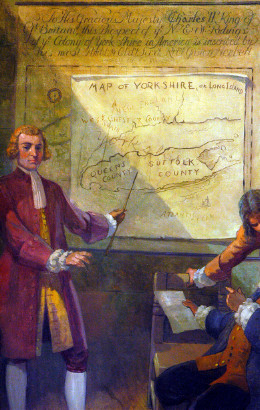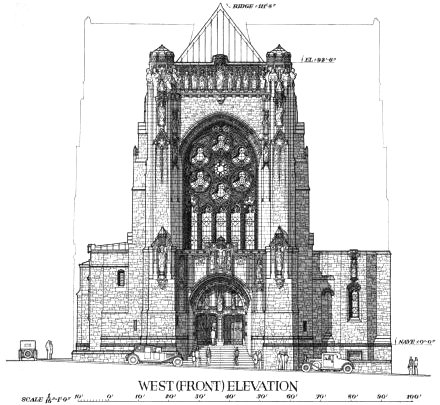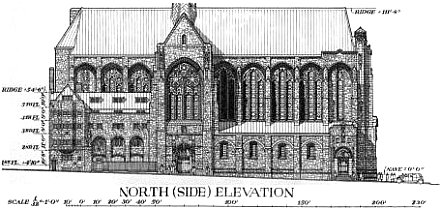Church
About Andrew Cusack
 Writer, web designer, etc.; born in New York; educated in Argentina, Scotland, and South Africa; now based in London.
Writer, web designer, etc.; born in New York; educated in Argentina, Scotland, and South Africa; now based in London. read more
News
Blogs
Reviews & Periodicals
Arts & Design
World
France
Mitteleuropa
Knickerbockers
Argentina
The Levant
Africa
Cape of Good Hope
Netherlands
Scandinavia
Québec
India
Muscovy
Germany
Academica
Interesting Juxtaposition
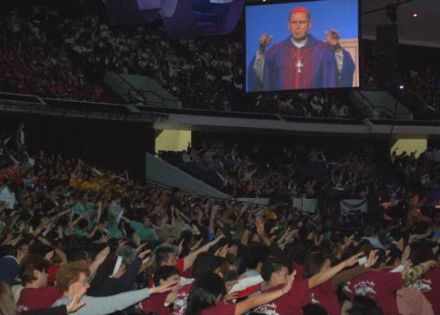
Above, the Los Angeles ‘Religious Education’ Congress. Below, the Berlin Olympics. No comment!
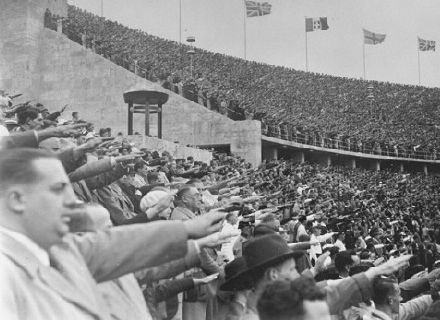
Thoughts of Late
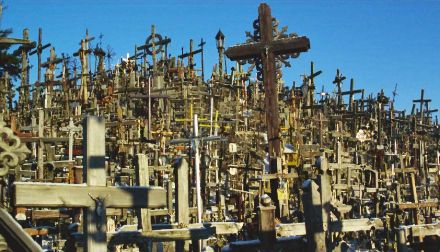
The Hill of Crosses in Lithuania. Over the years, the faithful left crosses on this hill to praise God and signify their appreciation for the many graces and mercies bestowed by Him. During the Soviet occupation of Lithuania, the hill was twice demolished and cleared by the Communists. Each time it was reconstructed by the people, and on its third appearance the Soviets finally allowed it to stay. Despite strong evidence of Christian faith such as this, the University of St Andrews ‘Christian Union’ claims that Lithuania is a heathen country, ‘with only 35 Christians’.
 During my presence at St Andrews over four years, it has snowed on a few occasions, though never stuck for more than a few minutes. I was much pleased, then, to awake on March 2 and spy through my windows (I never draw the curtains, as I enjoy the early morning sun) a blissful wintry utopia. The auld gray toon had been transformed into a veritable snow-globe, with snowflakes shifting back and forth with the wind as gravity drew them nearer their earthly home. Delightfully, this snow lasted, affording thousands of students myriad opportunities for heavenly mischief and giving me an excuse to put on my trusty Sportos. (Trusty Sportos seen at right).
During my presence at St Andrews over four years, it has snowed on a few occasions, though never stuck for more than a few minutes. I was much pleased, then, to awake on March 2 and spy through my windows (I never draw the curtains, as I enjoy the early morning sun) a blissful wintry utopia. The auld gray toon had been transformed into a veritable snow-globe, with snowflakes shifting back and forth with the wind as gravity drew them nearer their earthly home. Delightfully, this snow lasted, affording thousands of students myriad opportunities for heavenly mischief and giving me an excuse to put on my trusty Sportos. (Trusty Sportos seen at right).
But, woe of woes, I had a presentation to give that afternoon on the mundane and irascibly dull subject of the historiography of Indian/Settler relations in colonial America. I, and about four or five others out of a class of nearly twenty, duly arrived in the Old Library of St. John’s House at the appointed hour. We, the few, pondered where everyone else was. Had they autonomously declared a holiday? Risky business, considering this was a tutorial, and thus required, unlike lectures, of which I likely attended less than a third of my due during the past four years. A kindly secretary came in to inform us that Dr. Hart had cancelled the class and thus we were all free to frolic in the abundant snow to our little hearts’ content. Naturally, I just went to Rosary.
Speaking of Rosary, one day the week previous the post-Rosary revelry nearly drank the town dry. Well, perhaps I ought to give some background to our bliss. The Rosary is said every day Monday through Friday in St. James Church at 1:30 after which we all process across the street to the Common Room in Canmore. One or two of the girls, or Adrian if the girls are absent, make a round of tea for the merry band of Marian devotees. Well, on this frigid day in Scotland (a land of poorly-heated buildings, if one’s lucky enough to have heating on at all), we all huddled by the electric fire in our chairs, surmounted by a large communal blanket. Tom brought a bottle of port, of which we all partook, before I then excused myself to go off and do some equally time-wasting task. Well apparently the Rosary crew finished off that bottle of port, and then went and purchased another one! What’s more, the rapacious dipsomaniacs, once they had finished that bottle of port they emptied the reserve bottle of whiskey I keep hidden behind the German dictionaries in the library upstairs. Disgraceful! I have decided not to replenish the secret reserve, since, to put it in the vernacular parlance, is nae secret anaemoor!
Of course it’s my own fault for leaving it in the Chaplaincy. Should I have hidden it in the chaplaincy of the very friendly heretics over in St. Mary’s Place across from the Students Union, it would have remained unmolested. The worse that could happen would be the Christian Union forming a prayer circle around it and praying for the Good Lord to make it go away. (We Catholics already posess the knowledge on making drink disappear, and how!).
Ah, the ‘Christian Union’! Not in the entire English-speaking world, I daresay, does there exist a more delusional body of people. Everything about them is either hilariously funny or pitably sad, beginning with the irony of their very name. The Christian Union, as it styles itself, actually bans most Christians from joining. Those who wish to sign up (poor fools!) must be willing to sign a statement of faith extolling the tenets of the Evangelical Protestant religion. Thus Catholics, Orthodox, and even most Anglicans are not allowed to join. I have sometimes posited contacting whichever bureau of Britain’s behemoth government is responsible for truth in advertising and trying to get them to get the Christian Union to change their name. ‘Evangelical Society’ would be the most appropriate; while ‘Society of Over-Emotional Self-Deluding Followers of Feel-Good Teddy-Bear Christianity’ might be more accurate we must give some allowance for PR these days.
One of the latest projects of the Christian Union is to work for the ‘Christianization’ of Lithuania, “since there are only 35 Christians in the entire country”. It has apparently escaped the C.U. that Lithuania was Christianised ten centuries ago and has remained a vibrantly Christian country, even through decades of Soviet persecution. But perhaps we should leave them in their self-delusion, if only for the hilarity it provides for the rest of us. One can almost imagine them being given demographic information about the population of heaven, with thousands upon thousands of the patriarchs and prophets of the Old Testament, the apostles, the Church fathers, the martyrs, confessors, priests, nuns, and all the legions of holy souls: “But there are only 35 Christians!”
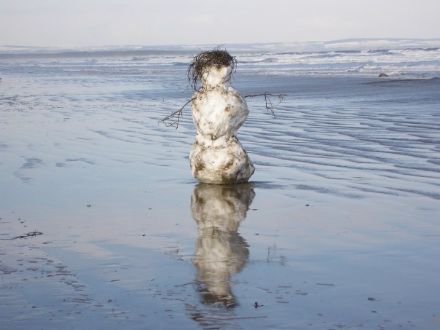
The Knights of Malta Ball 2006

BACK DOWN TO the Assembly Rooms of Edinburgh for the annual ritual of the Knights of Malta Ball and I am happy to report that, as per usual, a good time was had by all. We had a larger contingent heading down from the Auld Grey Toon than last year (when it was just Fräulein Hesser and myself), consisting of Abigail, Jon Burke, Stefano, Clare Dempsey, and yours truly. After gliding down from Fife via taxicab, we met up with Zygmunt Sikorski-Mazur, Jamie Bogle (sans Joanna, alas), and Gerald Warner at the Opal Lounge, a little past half six, and managed to pack in at least a round of drinks before heading across George Street to the Assembly Rooms (depicted in the engraving below).

Having dropped off our coats and such, we swept up the staircase to the Ballroom for some champagne before dinner. After mulling about and conversing for a while we bumped into the Cardinal Archbishop of St Andrews himself, H.E. Keith Patrick O’Brien, himself a Grand Cross Conventual Chaplain to the Order of Malta. We apologised for not maintaining his senior cathedral in St Andrews in the same state as his junior one in Edinburgh, but I did thank him profusely for allowing us an indult mass at Ravelston. (more…)
The 33rd March for Life
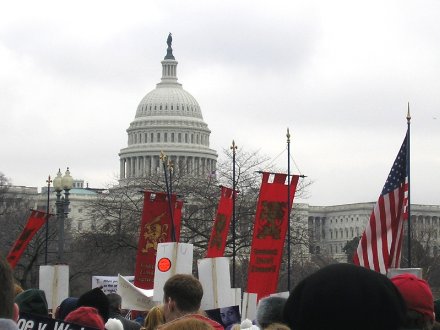
Yesterday I, and over 100,000 others, popped down to our nation’s capital for the annual March for Life held on the anniversary of Roe v. Wade. Despite the cold and passing rain, it was an event much enjoyed. I had never been to the March before, nor have I ever been to any sort of demonstration or rally of any kind for any cause. I recall, however, sitting in Canmore one day talking with the young Miss Clare Dempsey who worried over what the grandchildren of our generation might say when they look back remembering abortion and ask “What did you do to fight it?” Though it was comparitively little, waking up at 5:00 in the morning and sitting through a five-hour bus ride was a small price to pay in order to take part in the annual recollection of the devastating moment for the lives of the unborn and their mothers and fathers and family, and for our entire nation. (more…)
Thomas Dongan, 2nd Earl of Limerick
AS VIRGINIA, a year short of four centuries since her foundation, has only recently inaugurated her first Catholic governor, it might be an appropriate time to remember the first Catholic governor of New York, Thomas Dongan (right). Dongan’s tenure as Governor of the Province of New York was one of the most important in the history of our land, and witnessed the formative period of responsible government in what would eventually become the Empire State.
Thomas was born in 1634, the youngest son of Sir James Dongan, Bt., a Member of the Irish Parliament. After the regicide of Good King Charles in 1649, the Catholic family feared persecution and fled to France, as did the Royal Family. In France, having Gallicized his surname to D’Unguent, Thomas joined an Irish regiment and fought under the Vicomte de Turenne (who himself, born into Calvinism, became a Catholic in October 1668). Despite the Restoration of the Crown in Britain and Ireland, Dongan remained in France, being promoted to colonel in his fortieth year. The 1678 Treaty of Nijmegen, however, required all of Charles II’s subjects in the service of France to return home, and so Thomas obliged. Through the efforts of James, Duke of York, with whom Dongan had the privilege of serving in the French Army, he was granted a pension, a high-ranking commission, and was appointed Lieutenant-Governor of Tangiers, of all places, which (along with Bombay) had been given to England as part of the dowry of Catherine of Braganza.
It was in 1682 that James, Duke of York, as Lord Proprietor of New York, appointed Thomas Dongan to govern the bankrupt colony. “In this office,” the Catholic Encyclopedia says, “Dongan proved himself an able lawgiver, and left an indelible mark on political and constitutional history.” He convened the first representative assembly of the Province in 1683, which enacted the Charter of Liberties enunciating the form of government in New York. The Duke of York’s supreme legislative power as Lord Proprietor would reside in a governor, council, and general assembly. Members of the assembly were conferred rights and privileges making their august legislature coequal to and independent of Parliament. Courts of justice were established, liberty of conscience regarding religion was declared, and the principle of no taxation without representation was affirmed. Dongan signed the Charter of Liberties on 30 October 1683, and solemnly proclaimed it the next day at the Stadt Huys, New York’s city hall.
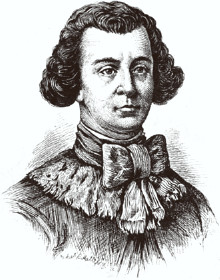 “Thus to Dongan’s term as governor,” quoth the Encyclopedia, “can be dated the Magna Charta of American constitutional liberties, for his system of government became the programme of continuous political agitation by the colonists of New York Province during the eighteenth century. It developed naturally into the present state government, and many of its principles passed into the framework of the Federal Government. Moreover, a rare tribute to his genius, the government imposed by him on New York Province, 1683, was adopted by England after the American War of Independence as the framework of her colonial policy, and constitutes the present [1909] form of government in Canada, Australia, and the Transvaal.”
“Thus to Dongan’s term as governor,” quoth the Encyclopedia, “can be dated the Magna Charta of American constitutional liberties, for his system of government became the programme of continuous political agitation by the colonists of New York Province during the eighteenth century. It developed naturally into the present state government, and many of its principles passed into the framework of the Federal Government. Moreover, a rare tribute to his genius, the government imposed by him on New York Province, 1683, was adopted by England after the American War of Independence as the framework of her colonial policy, and constitutes the present [1909] form of government in Canada, Australia, and the Transvaal.”
The peace and harmony of the Province was furthered in 1684 when Dongan, in the presence of Lord Howard, the Governor of Virginia, received the voluntary submission of the Iroquois confederacy to “the Great Sachem Charles”. The following year saw the death of Charles II and the ascent of the Lord Proprietor, James, Duke of York, to the thrones of England, Scotland, and Ireland. In that year of 1685, Dongan established a Post Office to strengthen communications within his colony and between all the English colonies in America. In the next year, 1686, the Governor granted civic charters to New York and Albany. Dongan’s charter for the City of New York lasted 135 years, while that of Albany was only replaced in 1870. Avid historians would have been bemused/irritated by Archdiocese’s celebration just a few years ago of the two-hundredth anniversary of Catholic education in New York. This would be because New York’s first Catholic school was not in the 1800’s during the republic’s early years but in the 1680’s when Governor Dongan established a college (in the secondary sense) under the guidance of three Jesuit priests, one of whom was his own private chaplain.
Despite the brief attempt to merge New York and New England, followed by the overthrow of James, our last Catholic king, in the so-called ‘Glorious Revolution’, Governor Dongan’s legacy in establishing the institutions of responsible government in New York remains. Indeed he was unquestionably New York’s greatest governor until the advent of ‘Magnus Apollo’ himself, DeWitt Clinton, in the nineteenth century. With the new Protestant Williamite administration in charge, Thomas Dongan returned to England in 1691 and, with the death of his elder brother, inherited the Earldom of Limerick under its first (1686) creation. He died in 1715, poor and childless. Nonetheless, as the Encyclopedia notes:
The tribute of history to his personal charm, his integrity, and character, is outspoken and universal. His public papers give evidence of a keen mind and a sense of humour. He was a man of courage, tact, and capacity, an able diplomat, and a statesman of prudence and remarkable foresight. In spite of the brief term of five years as Governor of New York Province, by virtue of the magnitude, of the enduring and far-reaching character of his achievements, he stands forth as one of the greatest constructive statesmen ever sent out by England for the government of any of her American colonial possessions.
The Basis of Peace is Truth
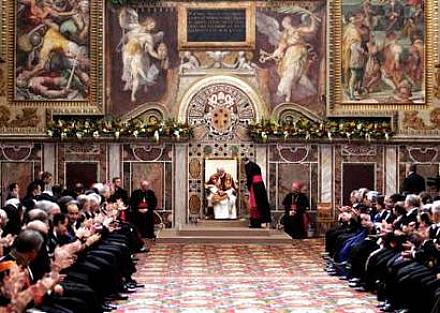
Yesterday morning the Holy Father addressed the corps of diplomats accredited to the Holy See. The address was given not his native German, nor the Church’s Latin, nor in the vernacular Italian, but rather in French being the language of diplomacy. The entirety of the Pope’s remarks is posted over at Whispers in the Loggia.
St. John Nepomuk Neumann
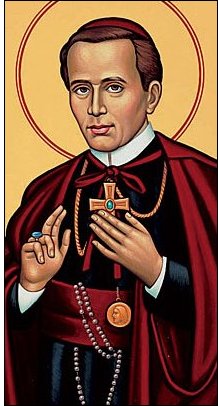 TODAY IS THE feast of St. John Neumann, the saintly Bishop of Philadelphia. St. John was born to a Czech mother and German father in Prachatice (Prachatitz), Bohemia and attended the Charles University in Prague with the intention of being ordained to the priesthood. His bishop, however, decided against any new ordinations as there were too many priests in Bohemia already (Just imagine!). John, fluent in six languages, wrote to other bishops in Europe seeking ordination until he decided to appeal to the episcopacy of the United States. He became the first Redemptorist in the New World when he took his vows in Baltimore in 1842. Six years later he became an American citizen, and just ten years later he was consecrated Bishop of Philadelphia.
TODAY IS THE feast of St. John Neumann, the saintly Bishop of Philadelphia. St. John was born to a Czech mother and German father in Prachatice (Prachatitz), Bohemia and attended the Charles University in Prague with the intention of being ordained to the priesthood. His bishop, however, decided against any new ordinations as there were too many priests in Bohemia already (Just imagine!). John, fluent in six languages, wrote to other bishops in Europe seeking ordination until he decided to appeal to the episcopacy of the United States. He became the first Redemptorist in the New World when he took his vows in Baltimore in 1842. Six years later he became an American citizen, and just ten years later he was consecrated Bishop of Philadelphia.
St. John Neumann built ninety-eight schools, fifty churches, and began construction on a cathedral, as well as writing two catechisms. His earthly remains are on view in Philadelphia to this day.
The Feast of the Nativity
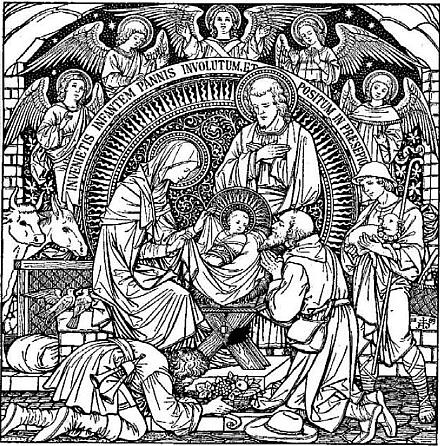
A very happy and blessed Christmas to you all!
Hypothetical Chicago Church
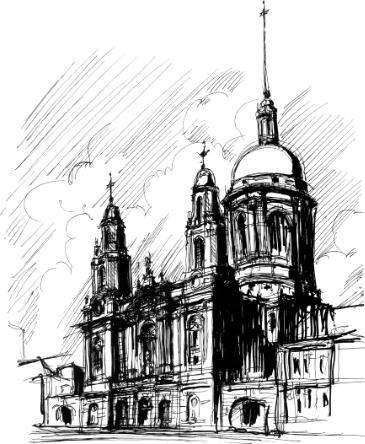
The clever kids over at Notre-Dame have struck again. Matthew Alderman (of Whapping fame) has published his hypothetical proposal for a church online and we thought we’d offer our most humble thoughts and comments upon the design. The Université de Nôtre-Dame du Lac over in South Bend, Indiana has arguably the best school of architecture in the country, if not all the Americas. Taking into account the state of most architecture schools these days, that isn’t saying much, but the School excels at teaching within the Western tradition of building, rather than inculcating the bland and soulless rejection of tradition which is modern architectural theory. You can see examples of the students’ works online at the School’s Student Gallery. (Of the rest, we found Lucas Hafeli’s art-nouveau mini-flatiron intriguing, as well as Erin Dwyer’s ferry terminal, and particularly enjoyed Brad Houston’s splendid arena). (more…)
The Feast of the Immaculate Conception of the Blessed Virgin Mary
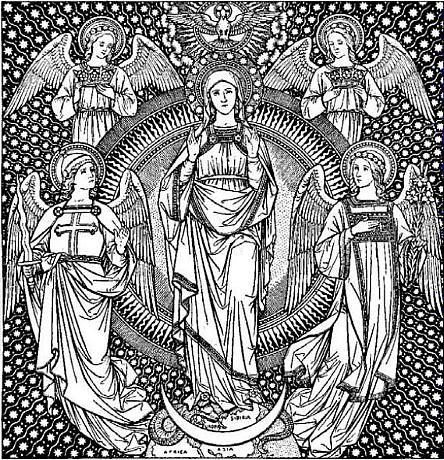
The Holy Father has declared a plenary indulgence for this day, which is also the patronal feast of the United States.
The following Act of Consecration was supposedly composed by Archbishop John Carroll, the first bishop of the United States (or Foederatarum Civitatum Americae Septentrionalis, to give it’s official Latin name).
Most Holy Trinity, we put the United States of America into the hands of Mary Immaculate in order that she may present the country to You. Through her we wish to thank You for the great resources of this land and for the freedom which has been its heritage. Through the intercession of Mary, have mercy on the Catholic Church in America. Grant us peace. Have mercy on our President and on all the officers of our government. Grant us a fruitful economy, born of justice and charity. Have mercy on capital and industry and labor. Protect the family life of the nation. Guard the precious gift of many religious vocations. Through the intercession of Our Mother, have mercy on the sick, the tempted, sinners – on all who are in need.
Mary, Immaculate Virgin, Our Mother, Patroness of our land, we praise you and honor you and give ourselves to you. Protect us from every harm. Pray for us, that acting always according to your will and the Will of your Divine Son, we may live and die pleasing to God. Amen.
O Blessed Nicholas
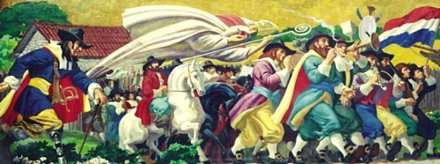
A very happy and blessed St. Nicholas Day to you all. St Nicholas is, as you all know, the patron saint of New York owing to our Netherlandish forefathers. Above you can see Lumen Martin Winter’s mural of St. Nicholas leading Peter Stuyvesant’s legion on their way to attack and take the Swedish fort of Christiania in New Sweden. The account of the battle by Washington Irving is hilarious and counts among my favorite selections of comic writing.
If you’d like to learn more about St. Nicholas, the St. Nicholas Center is a good place to start, as well as the holy bishop’s entry in the Catholic Encyclopedia.
It’s also Sofie von Hauch’s birthday. Tillykke med Fødselsdagen!
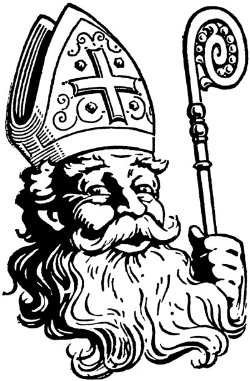
Previously: The Feast of St Nicholas
Dilbert on Gilbert
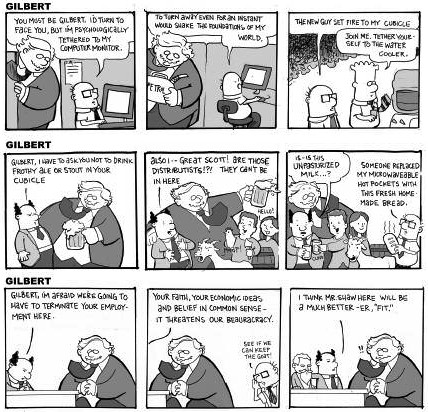
A recent Gilbert magazine featured G.K. himself interpolated into the popular Dilbert comic strip by Scott Adams. The text is quite small so I shall reproduce it below: (more…)
The New Shrine from Above
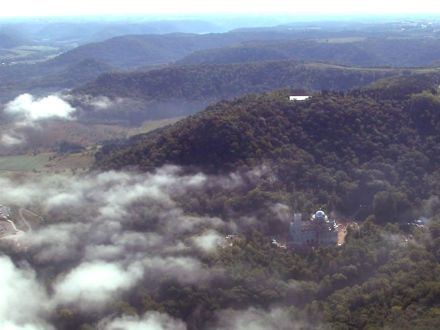
Via the Whapsters, we bring you this rather nifty shot of the Shrine of Our Lady of Guadalupe still under construction in the Diocese of LaCrosse, Wisconsin.
Previously: Patroness of the Americas
Chauncey Devereux Stillman
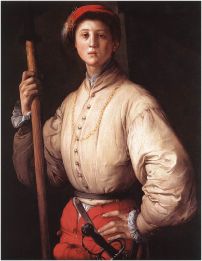 by Rev. George W. Rutler (via CERC)
by Rev. George W. Rutler (via CERC)
Of wealth and war, Chauncey Devereux Stillman (1907-1989) knew much and said little.
In his country home in Dutchess County, now a museum he endowed, is a youthful portrait that makes it easy to imagine Chauncey in Paris in the Roaring Twenties. In 1942, the future commodore of the New York Yacht Club donated his gorgeous flagship Westerly as a patrol boat on the lookout for German submarines.
Schools and charities flourished by his philanthropy, especially after his embrace of Catholicism. The Gentleman of His Holiness was an efficient cause of many of the Church’s most vigorous new academic and cultural institutions.
The last Mass he heard was in his Madison Avenue apartment, and his whispered request of me was that the sign of peace be omitted “because the butler finds it awkward.” … Continue in full
A Gothic Abbey in Virginia
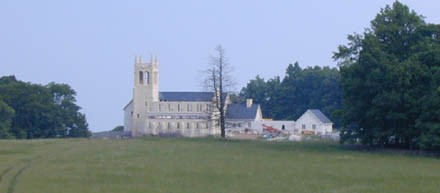
HDB/Cram and Ferguson has designed a Gothic abbey for an apparently schismatic Benedictine congregation in the mists of the Blue Ridge mountains of Virginia. It looks as if it will be very beautiful when finished but, alas, will not be open to the public as these Benedictines seem to greatly value their privacy. See the article, ‘In Virginia, a monastery rises in the mountains‘ (Associated Press, 2004).
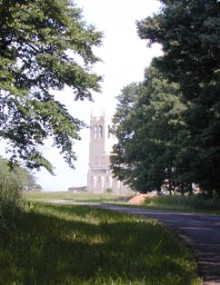
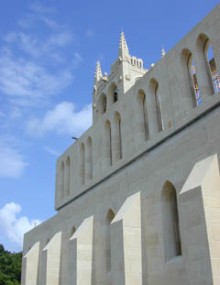
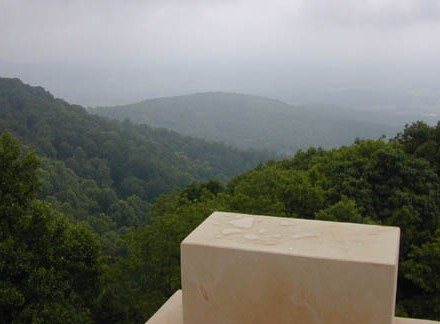
Cassock Pursuivant
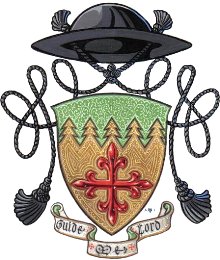 Last night the G&B played host to a lecture by one Fr. Guy Selvester, America’s ecclesiastical heraldist extraordinaire (arms at right). The good Reverend clearly has an unadulterated and unaffected love for heraldry, which, as he was very keen to point out, is unquestionably both an art and a science. He also has flaming red sideburns which give one the vague impression that he was a Civil War chaplain in a past life. After a brief introduction from a member of the G&B’s heraldry committee, the cassocked Father Guy gave a very clear and well-delivered talk, amply displaying his broad and deep knowledge of the subject, especially when responding to off-the-cuff inquiries from the audience.
Last night the G&B played host to a lecture by one Fr. Guy Selvester, America’s ecclesiastical heraldist extraordinaire (arms at right). The good Reverend clearly has an unadulterated and unaffected love for heraldry, which, as he was very keen to point out, is unquestionably both an art and a science. He also has flaming red sideburns which give one the vague impression that he was a Civil War chaplain in a past life. After a brief introduction from a member of the G&B’s heraldry committee, the cassocked Father Guy gave a very clear and well-delivered talk, amply displaying his broad and deep knowledge of the subject, especially when responding to off-the-cuff inquiries from the audience.
Of course no talk on ecclesiastical heraldry would be complete without mentioning the late Bruno Heim, the expert on church heraldry as well as Grand Prior of the Constantinian Order and the first full papal nuncio to the Court of St. James since the Reformation. Heim’s book Heraldry in the Catholic Church (available in the St Andrews University Library) is the essential work on the subject. Fr. Selvester interestingly pointed out that Blessed Pope John XXIII intended to found a heraldic authority for the Church. He was dissuaded from this task by none other than Archbishop Heim, who believed the Church covered too far broad a swathe to effectively and appropriately constitute its own heraldic authority mindful of the vernacular traditions. (more…)
Remembering Gemayel

September 14 is the twenty-third anniversary of the assasination of the Catholic general and politician Bachir Gemayel by Syrian agents, only nine days before he was to be inaugurated as President of Lebanon. Gemayel was the son of Pierre Gemayel, the founder of the Lebanese Kataeb (Phalange) which Bachir eventually led himself, and was also instrumental in unifying the Christian militias of the country into the Lebanese Forces, which joined with the conventional Lebanese Armed Forces in their 100-day attempt to expel the Syrians from Lebanon in 1978.
A massive bomb exploded in the Kataeb headquarters on September 14, 1982, killing the President-elect and twenty-four other souls. The assasination only further escalated the violence of the Civil War, a conflict which was taken to regretable extremes by all the parties invovled. (more…)
Cappa Magna Sighting
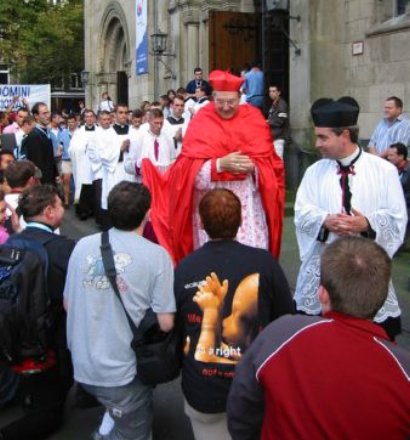
His Eminence George Cardinal Pell, the Archbishop of Sydney, happily donned the traditional (and these days rarely seen) cappa magna during his presence amongst the Juventutem pilgrims at the recent World Youth Day in Germany. His Eminence, known for his Australian candor, is seen above blessing young folks outside the Düsseldorf church designated for the use of the Juventutem traditional Catholic youth.
The Catholic Encyclopedia informs us that the “great cope” is not a liturgical vestment per se but rather a glorified version of the cappa choralis (choir cope), and is reserved for cardinals, bishops, and certain privileged prelates.
Photos from the FSSP.
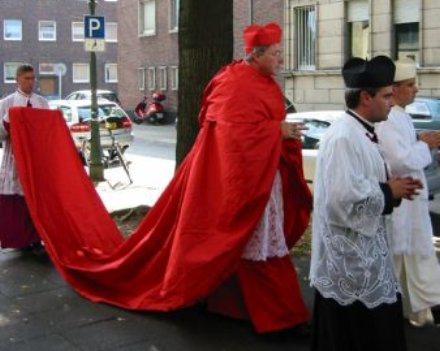
The Story of Notre Dame de Bon Secours
The background story to Nôtre Dame de Bons Secours, from the Catholic Community Forum:
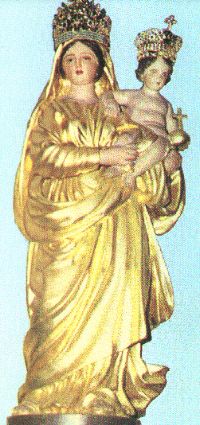 In 1727, French Ursuline nuns founded a monastery in New Orleans, Louisiana, and organized their area schools from it. In 1763 Louisiana became a Spanish possession, and Spanish sisters came to assist. In 1800 the territory reverted back to France, and the Spanish sisters fled in the face of France anti-Catholicsm. In 1803, short on teachers, Mother Saint Andre Madier requested reinforcements in the form of more sisters from France. The relative to whom she wrote, Mother Saint Michel, was running a Catholic boarding school for girls. Bishop Fournier, short-handed due to the repressions of the French Revolution, declined to send any sisters. Mother Saint Michel was given permission to appeal to the pope. The pope was a prisoner of Napoleon, and it seemed unlikely he would even receive her letter of petition. Mother Saint Michel prayed,
In 1727, French Ursuline nuns founded a monastery in New Orleans, Louisiana, and organized their area schools from it. In 1763 Louisiana became a Spanish possession, and Spanish sisters came to assist. In 1800 the territory reverted back to France, and the Spanish sisters fled in the face of France anti-Catholicsm. In 1803, short on teachers, Mother Saint Andre Madier requested reinforcements in the form of more sisters from France. The relative to whom she wrote, Mother Saint Michel, was running a Catholic boarding school for girls. Bishop Fournier, short-handed due to the repressions of the French Revolution, declined to send any sisters. Mother Saint Michel was given permission to appeal to the pope. The pope was a prisoner of Napoleon, and it seemed unlikely he would even receive her letter of petition. Mother Saint Michel prayed,
O most Holy Virgin Mary, if you obtain for me a prompt and favorable answer to this letter, I promise to have you honored at New Orleans under the title of Our Lady of Prompt Succor.
and sent her letter on 19 March 1809. Against all odds, she received a response on 29 April 1809. The pope granted her request, and Mother Saint Michel, commissioned a statue of Our Lady of Prompt Succor holding the Infant Jesus. Bishop Fournier blessed the statue and Mother’s work.
Mother Saint Michel and several postulants came to New Orleans on 31 December 1810. They brought the statue with them, and placed it in the monastery chapel. Since then, Our Lady of Prompt Succor has interceded for those who have sought her help.
A great fire threatened the Ursuline monastery in 1812. A lay sister brought the statue to the window and Mother Saint Michel prayed
Our Lady of Prompt Succor, we are lost if you do not come to our aid.
The wind changed direction, turned the fire away, and saved the monastery.
Our Lady interceded again at the Battle of New Orleans in 1815. Many faithful, including wives and daughters of American soldiers, gathered in the Ursuline chapel before the statue of Our Lady of Prompt Succor, and spent the night before the battle in prayer. They asked Our Lady for the victory of the American forces over the British, which would save the city from being sacked. General Andrew Jackson and two hundred men from around the South won a remarkable victory over a superior British force in a battle that lasted twenty-five minutes, and saw few American casualties.
It is still customary for the devout of New Orleans to pray before the statue of Our Lady of Prompt Succor whenever a hurricane threatens New Orleans.
Hat tip: Irish Elk. The image used below is of the National Shrine of Our Lady of Prompt Succor in New Orleans.
Search
Instagram: @andcusack
Click here for my Instagram photos.Most Recent Posts
- Faithful Shepherd of the Falklands April 8, 2025
- Articles of Note: 8 April 2025 April 8, 2025
- Proportionality Destroys Representation April 8, 2025
- Sag Harbor Cinema March 26, 2025
- Teutonic Takeover March 10, 2025
Most Recent Comments
Book Wishlist
Monthly Archives
Categories

